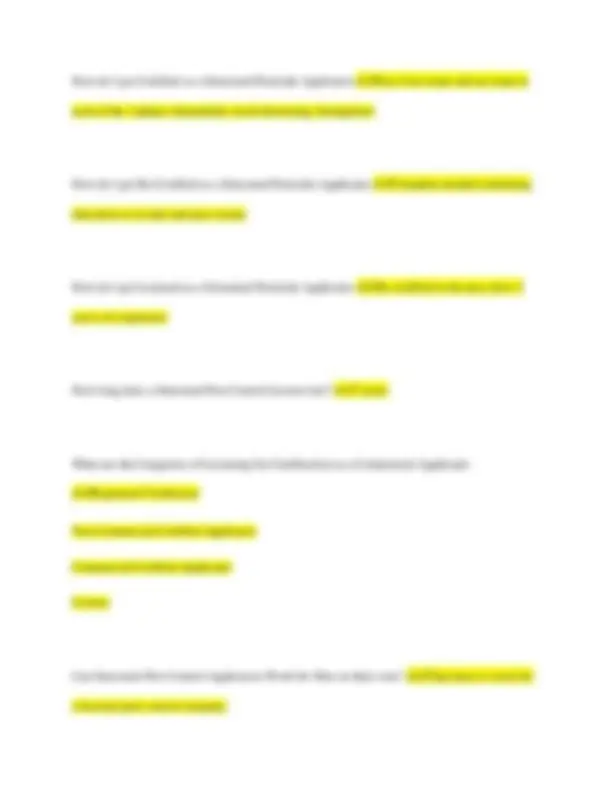





















Study with the several resources on Docsity

Earn points by helping other students or get them with a premium plan


Prepare for your exams
Study with the several resources on Docsity

Earn points to download
Earn points by helping other students or get them with a premium plan
Community
Ask the community for help and clear up your study doubts
Discover the best universities in your country according to Docsity users
Free resources
Download our free guides on studying techniques, anxiety management strategies, and thesis advice from Docsity tutors
A comprehensive overview of the north carolina pesticide application license, covering key aspects such as restricted-use pesticides, certification requirements, and pesticide management practices. It includes questions and answers related to various topics, including pesticide regulations, storage, and application methods. Valuable for individuals seeking to understand the legal and practical aspects of pesticide use in north carolina.
Typology: Exams
1 / 27

This page cannot be seen from the preview
Don't miss anything!




















Chapeter 1: General-Use Pesticide ✔✔Not that harmful
You do not need to be certified to apply
Restricted-Use Pesticide ✔✔Can be harmful to humans and the environment
You must be a CERTIFIED applicator or supervised by one
Private Pesticide Applicator Definition
Examples ✔✔Use or supervise use of RESTRICTED-USE Pesticides on their own property, rented property, or employer property
Farmer, nursery operator, sod producers
Commercial Pesticide Applicator ✔✔Use or supervise use of RESTRICTED-USE Pesticides on someone elses' property for payment
Public Applicator ✔✔Use or supervise use of RESTRICTED-USE Pesticides as part of government job
Structural Pest Control Operator
3 Areas ✔✔Must be licensed or supervised by a licensed person. Use Restricted-Use pesticides in or around STRUCTURES
Household, Wood Destroying, Fumigation
How do I get Certified as a Commercial Applicator ✔✔Pass 2 exams (core and specialized), lasts 5 years
How do I get Re-Certified as a Commercial Applicator ✔✔Earn the required hours of Continuing Education or Take and Pass the exams again
How do I get Licensed as a Commercial Applicator ✔✔Pass both core and specialty exam and earn License - Must renew at the end of each year
Chapter 2: Federal Insecticide, Fungicide, and Rodenticide (FIFRA) Act ✔✔Ruled by the Environmental Protection Agency (EPA)
Register products based on possible effects to people and the environment
What is important about a Pesticide Label ✔✔People who don't follow it are BREAKING THE LAW
What does the EPA do? ✔✔Re-evaluate older pesticides
Review every pesticide on a 15 year cycle
Establish safety rules for workers
What can STATES do to regulate pesticides? ✔✔They must follow EPA guidelines at a minimum
They can make even harder guidelines
Is there a special ACT that relates to food and feed products? ✔✔Federal Food, Drug, and Cosmetic Act established tolerance levels for food - how much residue of a pesticide is allowed
Food Quality Protection Act ✔✔Requires the EPA to establish a tolerance low enough that no harm can come to humans or environment
Hazard Communication Standards Act ✔✔Requires employers to list all hazardous chemicals in the workplace, obtain material safety data on each one, ensure containers are labeled, train workers how to deal with materials
NC Pesticide Law if 1971 ✔✔established management program designed to regulate the registration, handling, storage and disposal of pesticides
manage licensing for all pesticide users (EXCEPT Structural - they are handled by another law)
How should you STORE pesticides? ✔✔Tightly sealed
labeled
dry
Not around food
Not around combustible (FIRE Causing) materials
What does the NC Pesticide Board do? ✔✔Adopts regulations that detail acceptable pesticide use and licensing
Chapter 3: 3 Pest Management Goals ✔✔Prevention - keep it from happening
Suppression - reduce levels
Eradication - eliminate totally
Why is identification, monitoring and treatment threshold important? ✔✔Pest control can fail if you don't know what you are treating, identification can help you find the best thing to use as treatment
Treatment Threshold ✔✔Determine if you need to use any treatment. If treatment would cause more harm and cost more, sometimes you should wait or let the pest stay
Ways to control pests without pesticides ✔✔Natural control (weather, climate)
Biological - using natural enemies
mechanical - screens, traps, fences
Cultural - alter the environment to help with control (example - crop rotation)
Physical or Environmental - like lower humidity, refrigeration
Host Resistance - some plants are naturally resistant or can be genetically altered to be resistant
How do you do Integrated Pest Management? (IPM) ✔✔identify the pest
monitor the pest
determine if threshold levels have been reached (will the damage caused by doing nothing be bad enough to warrant treatment?)
consider various choices
implement the least harmful choice
record and evaluate
Why is IPM a good practice? ✔✔Maintain balance in ecosystem
meet public demand for responsible use
save money
prolong the usefulness of pesticides
List 4 Ways Pest Control could fail ✔✔1. Incorrect Pest Id
What is the best thing to do as a Biological Control Method? ✔✔Enhance natural enemies
If you use Exclusion to control pests, what do you do? ✔✔seal cracks and crevices
Describe Cultural Control Method ✔✔Alter the environment
Alter the condition of the host
Alter the behavior of the pest
When is Regulatory Pest Control most used? ✔✔airports and ocean ports
What is the biggest goal of IPM? ✔✔Maintain damage at acceptable economic levels
What is a preventative pest management strategy? ✔✔Plant weed and disease free seed
What is important about an Action Threshold? ✔✔By determining if/how much of the pest is acceptable you may help keep a pest from getting immune to the pesticide
Chapter 4: EPA Registration Number ✔✔Tells you that the product is registered by the EPA
EPA Establishment Number ✔✔Tells you where the product was packaged
What is Nomotodes 3 E? ✔✔A highly dangerous and restricted use pesticide that can only be purchased by professionals
DANGER on a label means what? ✔✔Highly toxic
Skull and crossbones indicates what? ✔✔Can get into the body in many ways (lungs, skin etc) and is highly toxic
Treatment for Swallowing Nomotodes ✔✔rinse out the mouth and take small sips of water
Call poison control
get medical assistance
What protective equipment should you use with Nomotodes? ✔✔barrier laminate gloves, protective suit, eyewear
What is a Wettable Powder? ✔✔a formulation that requires constant agitation when mixed with water
What is an Emulsifiable concentrate? ✔✔contains a liquid active ingredient, some petroleum based solvents, and an agent (emulsifier) that allows it to be mixed with water
What is a disadvantage of Emulsifiable concentrate and concentrates? ✔✔Rubber and plastic hoses, gaskets and pumps might deteriorate
What is a Water Dispersible Granule? ✔✔A dry/solid formulation which you mix in water with low risk of inhalation
What are Pellets? ✔✔A dry/solid formulation that is made up of particles the same weight and shape
What is Microencapsulated material?
Why are they good? ✔✔liquid or dry pesticide covered in a plastic coating
They have delayed, slow release of the active ingredient and prolong effectiveness
What is an Adjuvant? ✔✔a chemical that has no pesticide activity but can be added to a pesticide to make it work better
What is a Surfactant? ✔✔A surface active ingredient - helps the surface take in the pesticide example - wetting agent, spreader
Chapter 6: What are 4 Ways Pesticides can move in the Environment? ✔✔Air, Soil/Water, Movement on equipment or clothing, Animals
What is a Soluable pesticide? ✔✔Dissolves easily in liquid, may move in water
Point Source Pollution ✔✔Comes from a single, identifiable place or event (a spill, improper handling, improper disposal)
Non-Point Source Pollution ✔✔pesticides that dissolve and move through the soil after a rain fall is an example of this
Leaching ✔✔pesticide breaks down and moves into the water
How will I know if a pesticide can harm endangered species? ✔✔The label will say to consult a county bulletin for any special precautions.
Chapter 7: Pesticide Toxicity ✔✔The capacity of a pesticide to cause short term or long term injury -- Tells how poisonous it is
Pesticide Exposure ✔✔When a pesticide gets onto or into the body
Pesticide Hazard ✔✔Toxicity X Exposure
Acute injury ✔✔how poisonous the pesticide after only 1 exposure
Chronic injury ✔✔how poisonous the pesticide is after many uses over time
How can a pesticide enter the body? ✔✔1. Skin
Contact Effects ✔✔take place at the point of contact - itchy skin, watery eyes, sneezing,
Systemic Effects ✔✔Affect part of the body away from the original point o fcontact - nausea, headache, sweating, cramps
Immediate or Delayed Effects ✔✔sometimes illness can happen right away (immediate)
sometimes illness can occur weeks/months/years later (delayed)
Allergic Effects ✔✔Harmful effects only some people develop in reaction to substances - usually takes more than one exposure to become allergic
What are the symptoms of pesticide exposure ✔✔Mild - fatigue, headache, dizziness, sweating, nausea
Moderate - weakness, cannot walk, chest discomfort,
Severe - fainting, muscle twitching, running nose, drooling, coma
What are symptoms of heat stress ✔✔Fatigue
Keep victim's chin up to keep airways open
Chapter 8: Personal Protective Equipment ✔✔All pesticide handlers and early entry ag workers are legally required to follow PPE label instructions
Might be different requirements for handlers and early entry workers
Label will tell minimum but you can always add more for even better safety
What is a Fit Check for a Respirator? ✔✔Test for seal each time you wear it to make sure there is a tight fit and no leakage
What is Disposable PPE? ✔✔can wear for brief pesticide handling and then discard
How do you wash contaminated PPE? ✔✔Wash in machine - only a few items at a time
Use hot water and wash twice
Run another cycle after removing PPE
What is the most important thing about Respirator Maintenance? ✔✔Store cartridges in an airtight bag
What is the best way to protect pesticides in transit? ✔✔Use enclosed cargo boxes if possible
Where is a good place to have a pesticide storage facility? ✔✔A place with good soil land surface characteristics
How can you protect yourself from a damaged pesticide container? ✔✔Put on PPE
Chapter 9: How can you minimize storage problems? ✔✔Mark each item with purchase date
keep records of previous usage
Look at label for shelf life info
Risk Assessment ✔✔First step in developing a security program
Chapter 10: How do you handle a Liquid Pesticide Spill? ✔✔Always wear PPE